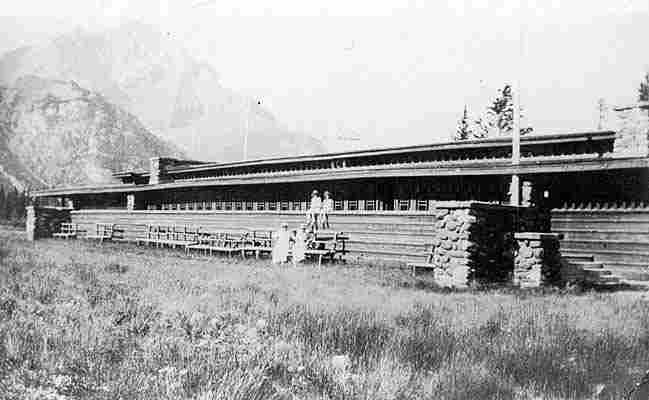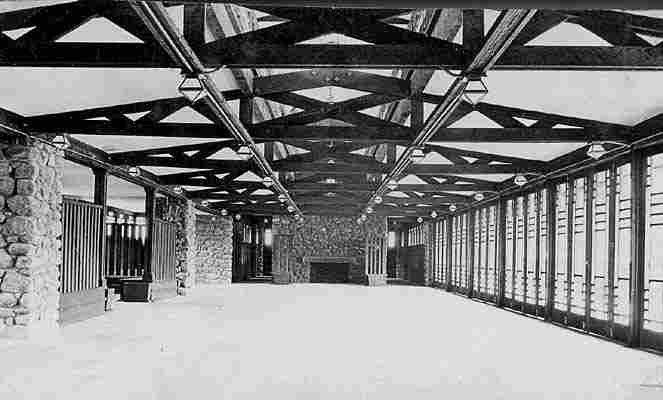Frank Lloyd Wright designed more than a thousand buildings in his 70-year career. About 500 of them were built, but Wright also “lost” several of his works, including the majestic Larkin Administration Building in Buffalo (1906–1950) and the Banff National Park Pavilion (designed by Wright and his student Francis Conroy Sullivan) for a site in the Canadian Rockies. Completed in 1914, the pavilion was demolished in 1939 after suffering severe flood damage.
Now an American filmmaker is taking steps to recreate the building on its original site in Banff National Park. Michael Miner, a Florida-based documentarian who has made four films on Wright, established the Frank Lloyd Wright Revival Initiative in 2016. One of its first acts was to solicit proposals for creating the drawings that would be needed to reconstruct the Banff Pavilion. The original Wright drawings are incomplete and, in any case, would not meet modern building codes, says Evie Eshpeter, a spokesperson for the project. She adds that accessibility and flood protection are two issues that could require tweaks to Wright’s original design. But the request for proposals was aimed at architects who were willing to update Wright’s building “without adding their own spin to it. This is not a collaboration,” she explains, but a re-creation.

A photo of the pavilion circa 1920.
The request for proposals elicited 30 responses from architecture firms and academic institutions, and last week a team from Ryerson University in Toronto was selected to carry out the task. The team consists of seven professors, including architects and engineers with specialties in historic restoration, environmental systems and controls, project management, architectural modeling, and building performance. Yew-Thong Leong, a practicing architect and Ryerson professor who is heading the team, says, “We are taking the project very, very seriously. To make sure the rebuild is authentic, we will make sure we have exhausted all available documents and then some.”
Leong says the professors’ research budgets were covering their costs, and that they expected to take a year to a year and a half to complete the necessary drawings. “There are no instructions on how to build this thing,” he says of the pavilion. “There are no details.” He says the team may visit other Wright buildings to try to determine what the architect intended. “We’re looking at Wright’s thinking at the time. We have the benefit of hindsight.” As for making sure the building is correctly positioned on its site, which now contains a baseball field, he says, “We have started an archaeological thread, talking to Egyptologists about how to scan for buried foundations.” He adds: “If it isn’t done right, we’re not interested. Pardon the pun."

A photo of the pavilion's interior circa 1913.
As designed by Wright more than 100 years ago, the low-slung building, nearly 200 feet long, contained a meeting room with dramatic wooden beams, three cobblestone fireplaces, and leaded-glass windows. The meeting room was flanked by restrooms.
Eshpeter says the city of Banff has given preliminary approval to the project, and that the cost of construction has been estimated at about $2 million.
It is not the first time Wright enthusiasts have tried to create new buildings from Wright designs. Early in the last decade, three posthumous Wright buildings—a boathouse, a mausoleum, and a gas station—were planned for the Buffalo area. At the time, several Wright scholars opposed the plans , which they says could likely damage the master’s legacy by passing off mediocre buildings as Wright’s. They noted that it is difficult, if not impossible, to find workers today who can build the kind of details Wright envisioned.
But according to Miner, the initiative has “the enthusiastic support” of Frank Lloyd Wright’s grandson, Eric Lloyd Wright; Bruce Brooks Pfeiffer, former director of the Frank Lloyd Wright Archive; and Arthur Dyson, a former Wright apprentice who practices in California. Miner has also set his sights on completing Wright’s 1963 Pilgrim Congregational Church in Redding, California, only part of which was ever built.

Leave a Reply